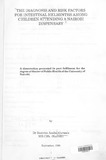| dc.contributor.author | Aluvaala, Beatrice A | |
| dc.date.accessioned | 2016-06-20T16:39:29Z | |
| dc.date.available | 2016-06-20T16:39:29Z | |
| dc.date.issued | 1990 | |
| dc.identifier.uri | http://hdl.handle.net/11295/96200 | |
| dc.description.abstract | In most health facilities in Kenya, the diagnosis of intestinal helminths has been and continues to be based on clinical criteria. This is the situation even in places where laboratory facilities are available.
It was therefore the main aim of this study to determine the reliability of this method. The study was carried out between March 1989 and June 1989 among children attending a Nairobi City dispensary.
A case-control study was conducted among the children aged 10 years and under. A case was any child 10 years and under who after medical consultation had an anthelminthic drug prescribed.
A control was any child 10 years and under who after medical consulation had no anthelminthic drug prescribed. 201 cases and 201 controls were included in the study. Of these, 163 stool specimens were received from the cases and 162 were received from the controls.
It was found that 47 (28.83%) of the cases had one or more intestinal helminths on stool examination. 16 (9.88 %) of the controls were also found to be infected with one or more worms. This over-diagnosis leads to the use of drugs and thus overexpenditure
on anti-helminthic drugs.
2
From this study it was found that the following socio-economic factors were associated with the presence of intestinal helminths:
1. Father’s education status
2. Mother’s education status
3. Child’s age
4. Father’s age
Clinically, the important signs and symptoms that revealed an association with intestinal helminth infection were :
1. Abdominal pain
2. Rumbling in abdomen
3. Pallor
4. Weight for age less than -2 standard deviations
5. Height for age less than -2 standard deviations.
3
The present method of management and control of intestinal helminths has been shown to be expensive and wasteful. Setting up a laboratory with a trained microscopist is much cheaper and in the long run a more effective control strategy. | en_US |
| dc.language.iso | en | en_US |
| dc.publisher | University Of Nairobi | en_US |
| dc.rights | Attribution-NonCommercial-NoDerivs 3.0 United States | * |
| dc.rights.uri | http://creativecommons.org/licenses/by-nc-nd/3.0/us/ | * |
| dc.title | The Diagnosis And Risk Factors For Intestinal Helminths Among Children Attending A Nairobi Dispensary | en_US |
| dc.type | Thesis | en_US |



